skip to main |
skip to sidebar
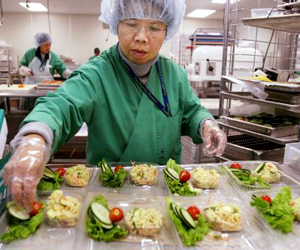 SAN FRANCISCO — On Wednesday morning, a white-coated food service worker hoisted a box of cherry tomatoes onto a steel table inside a massive commissary that provides almost 6,000 meals a day to 19 Kaiser Permanente medical centers in Northern California.
SAN FRANCISCO — On Wednesday morning, a white-coated food service worker hoisted a box of cherry tomatoes onto a steel table inside a massive commissary that provides almost 6,000 meals a day to 19 Kaiser Permanente medical centers in Northern California.
There was something revolutionary about this produce box. Written on one end was a Southeast Asian farmer's name, Vang Her, who owns a small farm near Fresno. Also scrawled on it were the words "pesticide free."
While farmer's markets have created robust new markets for local farmers selling directly to consumers, finding an efficient way for these small producers to strengthen their economic clout by also supplying institutional food providers has proven virtually impossible.
No longer.
In August, Kaiser Permanente launched a pilot project to purchase fruits and vegetables from small familyfarmers in California. It's created a novel distribution network that provides fresh, and sometimes organic, produce from small farms at roughly the same cost as that from industrial farms. In the process, even in its first few months, the project has lent more stability to the tenuous livelihoods of the small farmers supplying it.
"What Kaiser is showing is that it can be done," said Anya Fernald, director of food service programs for Community Alliance With Family Farmers, a Davis-based nonprofit that's coordinating Kaiser's locally sourced produce program.
"They're absolutely paving the way," she emphasized. "Their demand has built (distribution) pathways that other institutions can use, too." The University of California, San Francisco and Stanford University, among other institutions, have consulted with her group to explore expanding their purchases of local produce, she said.
The idea to use Kaiser's purchasing power to create new markets for small farmers, while improving produce quality, came from an environmental stewardship council run by Kaiser staff.
On that council was Dr. Preston Maring, a physician in the HMO's Oakland medical center. In 2003, he persuaded management to let him bring a farmer's market weekly to the Oakland medical center. It was such a hit that more than 30 farmers' markets are now held weekly at Kaiser medical centers in Northern California.
The success of Kaiser's farmers' markets, which provide patients, staff and the nearby community with easy access to fresh, often pesticide-free produce, got Maring thinking of other possibilities. Knowing the volume of produce purchased by the HMO — some 250 tons annually — he pushed to give local producers a piece of the business.
Just short of four months into the pilot project, Jan Sanders, national nutrition service director in procurement for Kaiser, estimates that local farmers have provided 40 tons of produce to feed patients in the hospital.
With their chicken-salad-on-whole-wheat-bread sandwiches, patients now get a cherry tomato. Sliced apples from a Stockton farmer and grapes from a small farmer in Madera are added to a fruit plate. Earlier this year, patients got locally grown kiwis, cantaloupes, mandarin oranges and strawberries.
Kaiser's new focus on fresh produce dovetails with its 2003 "Thrive" campaign, which encourages lifestyle changes to prevent disease.
"Within Kaiser Permanente, we're promoting 'Thrive,'" said Eirin Hilton, a registered dietitian with Kaiser who helps oversee food service production at the South San Francisco commissary, which is run by a Kaiser contractor, Food Service Partners.
"We have a real theme message here. When people eat well, then they recover better," Hilton added.
"We really are walking our talk," emphasized Sanders. "Our primary goal is prevention, and our primary goal is to improve the health of our patients and our community."
A portion of the HMO's offerings still consists of prepared foods like pancakes, sausages and Danish pastry. But their presence also reflects patients' preferences, said Hilton. Had the current emphasis on fresh produce begun several years back, the initiative might have faltered, she said.
"There's a whole momentum changing with food and health," Hilton noted. "In the past, if we'd try to do this, we would have had major patient dissatisfaction."
But the growing interest in improving Americans' health through better diets is gratifying to her. "It's a health-care phenomenon that's given us humble dietitians a lot more recognition than we've ever had before," Hilton said.
The role Kaiser is playing in bolstering family farming operations is also a source of pride for Sanders and Hilton. The number of family-run farms also keeps declining statewide, said Fernald.
"These are small farmers that are supporting their families on 100 acres," Hilton said. Farmers from ethnic groups, such as the Hmong — tens of thousands of whom fled to California from Southeast Asia after the Vietnam War ended — get priority for supplying the program, although it's not exclusively minority-supplied, emphasized Fernald, with the family farmers' alliance.
She said 15 family-run farms contribute to the project, and she expects 30 by next summer. Kaiser now spends about $10,000 a month on locally sourced produce, and according to a financial analysis, is only spending $400 more a month than it would by purchasing from a distributor supplied by large farms, Fernald said.
And San Vang, a Fresno farmer who grows cherry tomatoes on his 2-acre plot, is now earning more per box by selling into the Kaiser program, as he has cut the cost of the middleman.
The new market for fresh produce — which will expand to other Kaiser facilities if the pilot is deemed a success — also helped at least one Hmong family salvage its crop this fall, Fernald said.
In October, a packing house in Fresno told nine Hmong families who each had farms growing cherry tomatoes that it wouldn't need their produce any longer, she said.
"Several families pulled out their plants," Fernald, even though they still bore tomatoes. "They just didn't have any other option. They couldn't establish new connections, because it was too late in the season."
But at least one of the families, she said, learned of Kaiser's locally grown-produce project, and has been able to sell its tomatoes into it for the past three months.
"No one's becoming a millionaire off of this," Fernald added. "It's that little edge that helps keep a farmer in business."
And as cherry tomato season in California winds down, Kaiser will turn to Mexico for its supply this winter. Eventually, Fernald hopes to even persuade the HMO to forgo even those markets.
"Go seasonal, like using persimmons on salads in the winter, instead of cherry tomatoes," Fernald said. Sweet potato sticks and dried fruit are another option, she said. Diners, she added, enjoy the variety and novelty.
"If we're able to encourage creativity, we can open up new opportunities for farmers," Fernald said.
But, she recognized, that type of change may take time. Until then, she's content moving "one step at a time."
from The San Mateo County Times
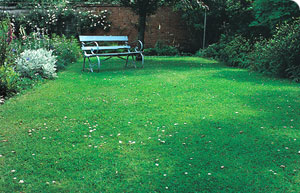 Emerging as a 6% sprout in the overall U.S. lawn and garden market, the latest market research from Packaged Facts shows sales of organic fertilizers and growth media (F/GM)—and to a lesser degree organic pesticides—blossoming over the next five years. With the market currently worth $360 million, Trends in Organic Lawn & Garden Products projects that the market will sustain double digit growth for each of the next five years, firmly rooting itself as a viable niche market at $670 million in 2011.
Emerging as a 6% sprout in the overall U.S. lawn and garden market, the latest market research from Packaged Facts shows sales of organic fertilizers and growth media (F/GM)—and to a lesser degree organic pesticides—blossoming over the next five years. With the market currently worth $360 million, Trends in Organic Lawn & Garden Products projects that the market will sustain double digit growth for each of the next five years, firmly rooting itself as a viable niche market at $670 million in 2011.
The new Packaged Facts report sees significant pressure building at the grassroots level to upend the status quo of synthetic or conventional supplies, which make up the bulk of the current $6 billion U.S. lawn and garden market. Just as other “green” or eco-friendly products are vigorously growing into other markets, lawn and garden organics are quickly becoming a viable alternative.
“Much of the grassroots success is coming from baby boomers, who through sheer force of their demographic size have the ability to shift the status quo in favor of an environmental utopia,” said Don Montuori, the publisher of Packaged Facts. “The fact that organic lawn and garden products fulfill this goal and that boomers are entering the traditional prime gardening years, speaks volumes to the potential for an organic groundswell.”
Currently, a majority of the marketers involved in organic L&G are primarily engaged in selling to the commercial agricultural and horticultural markets rather than to the consumer lawn and garden market. Yet as economic and environmental concerns continue to escalate, consumer interest at the home level is expected to increase as scientific advances continue to improve organic options.
from Press Release
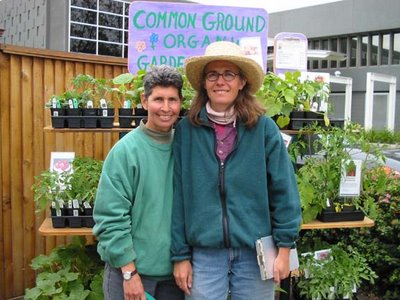 PALO ALTO, CALIFORNIA - Whether it's gardening classes, tools or supplies, Common Ground Organic Garden Supply and Education Center in Palo Alto has filled the bill for gardeners and mini-farmers for 34 years.
PALO ALTO, CALIFORNIA - Whether it's gardening classes, tools or supplies, Common Ground Organic Garden Supply and Education Center in Palo Alto has filled the bill for gardeners and mini-farmers for 34 years.
John Jeavons is executive director and a founder of Ecology Action of the Midpeninsula, a nonprofit environmental research and education organization that started in Palo Alto and later moved to Willits (Mendocino County).
Common Ground is one of Ecology Action's projects.
Ecology Action began in 1970 when a group of Palo Alto residents got together to start a recycling program in the city, said Patricia Becker, manager of the Common Ground center.
After the city took over the recycling program, Becker said, Ecology Action started four more projects: a bicycle workshop that also promoted bicycle lanes in Palo Alto, the Common Ground education center, the Common Ground supply center and the half-acre Common Ground research, demonstration and biointensive garden at Syntex Corp. in Palo Alto.
The bicycle workshop evolved into the independent Wheelsmith bicycle repair shop and then into Wheelsmith Fabrications Inc., a maker of lightweight bicycle wheels that moved to Big Timber, Mont.
The garden was discontinued in 1981, a year before Ecology Action moved to Willits, where it has demonstration gardens and promotes biointensive mini-farming throughout the world.
Using organic and sustainable techniques developed by the late English horticulturist Alan Chadwick, biointensive practices emphasize ways to grow enough food for a family of four on much less land than required by conventional agriculture.
Those techniques stress seven factors used in combination:
-- Double-dug raised beds.
-- Composting.
-- Intensive planting.
-- Companion planting -- plants that do well together or that attract or repel insects.
-- Carbon farming -- feed and grain crops such as corn, wheat, millet, amaranth and oats that produce a large number of calories and make good compost.
-- Calorie farming -- high-calorie crops such as potatoes, sweet potatoes and parsnips.
-- Open-pollinated seeds rather than hybrids.
Jeavons describes these techniques in his "How to Grow More Vegetables (and Fruits, Nuts, Berries, Grains and Other Crops) Than You Ever Thought Possible on Less Land Than You Can Imagine." Originally written in 1974, the book will come out in a seventh edition from Ten Speed Press this month.
Becker worked as Common Ground's class coordinator for four years. At that time, the center was at 225 El Camino Real. She became the center's manager in 2000 and supervised its move to 559 College Ave. in September 2001.
Originally from Pittsburgh, Becker became seriously interested in macrobiotics in her late 20s. Macrobiotics is a dietary approach that stresses whole grains, fresh vegetables, beans and other "seasonal, local and organic" foods, she said.
She came to California in 1984 to work as a macrobiotic chef in a Hillsborough couple's home. Since then, her career has taken her to such places as Harbin Hot Springs in Lake County and Hidden Villa Organic Farm and Wilderness Preserve in Los Altos Hills.
She describes Common Ground as follows: "It's community; it's gardening; it's education."
"We want to have what people need" for gardening. She also wants it to carry locally made items such as jams, honey, soaps and crafts.
In addition, the center sells high-quality garden tools. It has a lending library for members (basic membership costs $25 a year) and a reference library for in-store reading.
Customers can buy more than 500 varieties of seeds in jars or packets, vegetable and herb seedlings, native plants, organic fertilizers and soil conditioners, and natural pest control products.
Common Ground also offers classes ranging from an introduction to permaculture to composting techniques and designing sustainable landscapes. A complete schedule is at commongroundinpaloalto.org.
Harking back to its roots, the center plans to develop a garden on land offered by the Palo Alto Christian Reformed Church on Arastradero Road, which will be used to demonstrate intensive gardening methods and to raise seedlings to sell at the center. It also will be an outdoor classroom.
Becker expects planting to start by the end of the year. The center is still looking for a sponsor to provide funds to hire a full- or three-quarter-time gardener, she said.
from The San Francisco Chronicle
 Head to the grocery store these days, and almost everything on your shopping list has an organic equivalent. You can buy organic cereal, soup, chicken, cheese, and yes, even organic burgers.
Head to the grocery store these days, and almost everything on your shopping list has an organic equivalent. You can buy organic cereal, soup, chicken, cheese, and yes, even organic burgers.
Organic foods, including produce, meats, grains, and ingredients used to make various products, must be grown without the use of potentially harmful pesticides, chemical fertilizers, antibiotics, or growth hormones. We get healthier food when we eat organic. There are studies that suggest organic produce has higher nutrient levels and studies connecting health risks to the hormones and antibiotics” used in conventional animal products. Some nutritionists argue the differences are negligible, but eating an organic diet is greater than the sum of its parts, because like a savings account, the benefits accumulate over time.
Still, even with the introduction of lower-cost supermarket brands, conventional foods have one irresistibly attractive quality: price. Organic fruits and vegetables typically cost 10 to 30 percent more, and frozen produce, meats, eggs, milk, and processed foods like cereals, soups, and salad dressings run 50 to 100 percent more. So should a runner always shell out the extra cash for the healthier stuff?
Smart Shopping
There are clear differences among fruits and vegetables in their loads of pesticides. Some make sense to buy organic; others don’t matter as much By eating the organic versions of the dirty dozen, you can reduce your exposure to contaminants by 90 percent. If your budget or options are limited, don’t feel bad forgoing organic food. The reason for the difference in pesticide levels varies from crop to crop; some foods require more pesticides than others, and some have their own protective shell, like the skin of a mango or a banana peel. And buy conventional, too, if you can’t find or afford organic produce. Eating fruits and vegetables for the multiple nutrients they provide is the more important thing. The bottom line is that some foods expose you to more contaminants than others. If you can afford to buy organic all the time, it’s better for you-and the planet.
Organic Shopping Guide
What does the label mean? The word organic can be used for both domestic and imported foods. Here’s what the other labels mean:
100 per cent Organic: All ingredients must be organic
Organic: Guarantees 95 per cent of the ingredients are organic
Made with organic ingredients: At least 70 per cent of the contents are organic
from Afternoon Dispatch & Courier
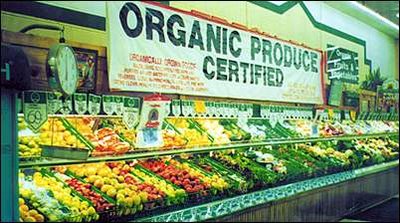 UNITED KINGDOM - Sales of organic produce in the UK have jumped 30% in a year and are now worth £1.6bn annually.
UNITED KINGDOM - Sales of organic produce in the UK have jumped 30% in a year and are now worth £1.6bn annually.
All the leading supermarkets have expanded their range of organic food rapidly in the last year and report dramatic growth in demand. Supermarkets accounted for £1.2bn of the total market for organic produce in 2005.
Sainsbury's and Waitrose were earliest to exploit demand but growth is now also strong in supermarkets with less affluent customers. Sainsbury's, Tesco and Waitrose all say they have seen growth in organic sales of around 20% year on year.
Tesco said that its organic fruit and vegetable sales were growing by 70%. One in three of its shoppers now buy some organic produce, according to a spokeswoman. Asda said it was aiming to sell 1,000 organic lines by Christmas, doubling the size of its range as it tries to catch up with the market leaders.
Half of shoppers in the most disadvantaged socio-economic groups now buy some organic produce, according to the Soil Association's annual assessment.
But as organic fortnight begins today, the success story comes with a warning. The organic farmers organisation, the Soil Association, says that supermarkets rushing to increase their share of the sector are making it harder for pioneeers of the movement to survive. Patrick Holden, director of the Soil Association, said: "A significant number of small organic businesses have suffered from supermarkets switching suppliers or abandoning a brand in favour of their own label production. There is a tyranny about own label products that allows supermarkets to abuse small producers. Customers need to insist on branded products."
Mr Holden said he knew of at least two suppliers who had been threatened with their products being delisted by a supermarket if they refused to switch their production to the supermarkets' own label.
The Guardian has spoken to several organic companies who confirm that they have been under pressure from major retailers but fear losing their business altogether if they are identified. The problems they report range from supermarkets selling their own label organic food at an unrealistic subsidised price to capture market share, to branded recipes being copied for own label lines and prices paid to producers being driven down below the cost of production.
Leading retailers deny that they are squeezing brand names out of the market. Asda, which says its organic sector has grown 30% year on year, said the increase had mostly been driven by branded products, since it was quicker to build on them than create new own label products. Tesco and Sainsbury's also said they worked closely with organic suppliers.
Both Tesco and Sainsbury's have recently announced that they will be running pilot schemes to deliver boxes of fruit and vegetables to individual houses. "In the lasts three years, we've seen a mindset change in people's attitudes towards food," said Alison Austin, head of sustainability at Sainsbury's.
The problem now was meeting demand. Organic meat was in short supply, and a shortage of forage meant supplies of British organic milk were unlikely to be sufficient come winter, she added.
from The Guardian Unlimited
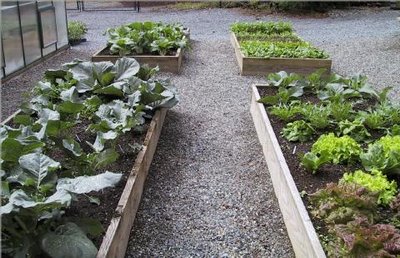 SAN BERNARDINO, CALIFORNIA - In the Inland Empire we can commence fall planting now through November. It is time to plant winter vegetables, bulbs, perennials, trees, shrubs and annuals.
SAN BERNARDINO, CALIFORNIA - In the Inland Empire we can commence fall planting now through November. It is time to plant winter vegetables, bulbs, perennials, trees, shrubs and annuals.
While it is still too hot to plant some bulb and annuals, take time out to make a list of the things that you want to accomplish before fallsets in. What new plants you want to plant, which ones need dividing,which area needs fertilizing, which garden bed needs to be prepared and enriched. Do you need to make some raised beds this year since theknees are not working as well as they did last year?
Prepare for fall planting toward the end of September. Fall is theperfect planting time as the weather promotes root growth. There is still time to plant summer annuals such as dwarf zinnia and marigolds, vinca, impatiens, petunias, and phlox. Perennial plants that can beplanted include carnations, sweet William, ageratum, lobelia, alyssum, columbine, lupine and hollyhock. The weather is still warm enough topromote rapid root growth before frost sets in.
Seeds of annuals and perennials can be planted in sterile soil incontainers while it is still hot. They will be ready to transplantwhen the weather is cooler. The container will help to keep soil fungus from attacking and killing the seedlings. If you decide to plant the cool-weather plants in your garden now, instead of waiting for cooler weather, be certain to protect the plants with some shade and water them faithfully.
Check your overgrown perennials such as agapanthus, columbines, calla and canna lilies, coral bells, daylilies, gazanias, geum, herbs, iris (replant in October), penstemon, phlox, Shasta daisy, etc., for dividing and replanting.
The following seeds can be sown now if you have prepared the ground with mulch and begin good watering practices: California and Mexican poppies, African daisies, annual candytuft, bachelor buttons, forget-me-nots (shade), larkspur, linaria, nemesia, sweet Williams, and winter flowering sweet peas. Spring flowering sweet peas can be planted in October through November. If you have an area for wildflowers, use this month to clear it of weeds so you can strew wild flower seeds after the first rain.
Other flower seeds that can be planted include ornamental cabbage, calendula, columbine, companula, coreopsis, cosmos, delphinium, foxglove, hollyhock, Johnny jump up, mimulus, nasturtium, pansy, penstemon, phlox, petunia, poppies (all varieties), salvia, snapdragon, and statice.
September continues the season for making cuttings and propagating fuchsias, geraniums, impatiens and other plants that could perish in a frost. Protect your cuttings from the sun and then the cold.
Roots and bulbs include artichoke, asparagus, horseradish, onion, garlic, shallot, and other vegetables as they become available at the stores.
Bulbs, corms and tubers will begin to appear on the shelves this month.It is a good idea to buy these now while they are fresh and large sizes are in good supply. Don't plant now; store the bulbs in a cool dry place for planting in October. Tulips, hyacinths and crocus do best if they are stored in the refrigerator for four to six weeks at 40 degrees before planting in November. November is the month to plant ranunculus; more about that next month.
After the leaves of daffodil and narcissus bulbs, gladiolus corms, andoriental lilies leaves have yellowed, they may be dug, cleaned and dried in the sun for a week. Store in a cool dry shady place until replanting season resumes in January.
Pruning requirements for September are usually limited to thinning outshrub where there is a risk of wind damage. Staking small trees that are vulnerable to winds is advisable also check trees to make certain the stakes are not too tight. Stake and tie chrysanthemum plants to prevent drooping and breaking. This is a good month for general cleanup and spraying with a horticultural spray.
Cut off dead blooms of roses and annuals to promote fall blooms. Cut back straggly petunias to two growth nodes beyond the old hardwood and feed them for more fall color.
Keep the ground moist, don't let the soil dry out. As it gets cooler,the soil still needs to have moisture for healthy plants. Don't forget to fill the bird baths every week this month with fresh water (mosquitoes breed in stale water). Withhold water from your lilac bushes from now until January to start their dormant period. Gradually reduce watering of your pomegranate bush to reduce fruit splitting.
September is a good time to fertilize fall blooming plants, such as roses, chrysanthemums and annuals. This is the last chance to feed citrus so that new growth will harden before cold weather sets in. Add iron chelates to plants which show signs of yellowing foliage, this includes azaleas.
Autumn vegetable seeds to start include beets, Brussels sprouts, carrots, cabbage, cauliflower, celery, lettuce, kohlrabi, leek, mesclun,onions (short day types), parsley, sugar peas, turnips, radishes,spinach, Swiss chard and turnips.
Preparation of lawns for reseeding can be done now, but cool weathergrasses should be planted in October or November when the weatherstabilizes. You can start lowering your lawn mower now for the winter.Wait until October to fertilize.
Container pots with spring and summer plants should be checked to see if they need to be replaced with cool-weather varieties such aschrysanthemums. Choose plants with interesting and intense foliage color and plant with annuals that will bloom later in the season.Existing containers need to be kept moist -- use a slow drip method (if the plant's root ball has dried out, it will not absorb water).
Clean up under azalea and camellia plants to prevent disease. Water shallow-rooted plants, these include tropical ferns, fuchsias, and hydrangeas.
Start collecting fall leaves, spent summer vegetables, annuals,perennials, and small shrubbery for the compost pile, compost will enhance next year's soil.
When planting young plants, control snails and slugs as they are just waiting for their next succulent meal.
from The San Bernardino Sun
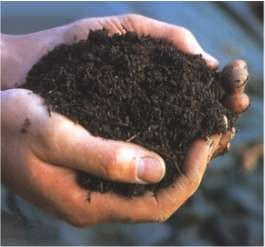 FLORIDA - Whether you're an apartment-dwelling window box gardener or a homeowner with a sizable spread, composting is a simple operation that will provide a bounty for your plants while helping cut down on landfill waste.
FLORIDA - Whether you're an apartment-dwelling window box gardener or a homeowner with a sizable spread, composting is a simple operation that will provide a bounty for your plants while helping cut down on landfill waste.
What is compost? Basically, it is organic matter that has been broken down by the action of insects and microorganisms into a rich substance that loosens soil, improves moisture retention and provides a tremendous host of nutritional benefits. Frequently, compost gardeners will find that they no longer need to buy chemical fertilizers and soil amendments.
How you compost will depend on your needs and your space availability. For apartment gardeners with a small patio, there are small barrel-type composters available at most garden centers and online. They usually consist of a small metal or plastic barrel with a hatch and a crank for turning the contents. They will turn out a batch of perfectly finished compost in a very short time.
For those you with a yard, the options are far more numerous. You can construct a "free-form" heap, with your items piled up loosely, although they don't work as efficiently and can be difficult to keep weed-free. The cheapest route, and the one most-used by hardcore composters, is the chicken-wire enclosure, using either 3- or 4-foot wire to make a circular enclosure of roughly the same diameter.
If you have wooden pallets, they can be nailed together to make an outstanding heap. Use heavy-duty hinges on one side to make it easy to open for turning and emptying.
Basically, any material that can be used to build a round or square enclosure can be a compost heap. The important thing is what goes into the enclosure ... namely just about everything. Grass clippings, leaves, plant trimmings and other non-weed yard waste is a good foundation, but don't forget about your kitchen. If you're a coffee drinker, your grounds (filter, too!) should go into the heap. They'll provide moisture and a great source of trace minerals. Making a salad? Put those trimmings, stems and skins into the heap. Even your breakfast-time eggshells make great compost, adding more minerals to the mixture. Anything organic can go in, but avoid meat and bones, as they will attract pests, not to mention the stink. You want a compost heap, not a junk yard.
As far as maintenance goes, you can do as much or as little as your schedule allows. The more often you turn the heap, the faster it will break down and provide you with your end result. I tend to let my three heaps fill, turning them occasionally, all during the spring and summer, then break them open in the fall and winter, when it's time to work the flower beds in preparation for spring planting.
Keep the heap moist, although if you have an open-topped heap in an average climate, Mother Nature should take care of that fairly well. Again, the more attention you pay to proper moisture levels, the faster you'll get your finished product.
When you do "harvest" your compost, be sure and save a couple of bucketfuls to use as "starter" for the next go-round. That will provide a dose of the microorganisms and bacteria that dig in and start munching on your raw materials.
And where can you use your black gold? Anything green and growing will benefit from a dose of compost. For new plantings, use one part compost to four parts soil. For existing plants, in pots or gardens, gently work a layer of compost into the top layer of soil around the base of the plant. You can even spread it in your yard by hand or with a broadcast spreader to make your grass the envy of the neighborhood and help cut down on your watering.
One final tip for those of you using traditional on-ground heaps: Every couple of years, change where they are placed. Plant pumpkins in the old spots. You'll grow the biggest jack-o'-lanterns ever!
from NBC6
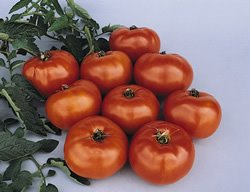 Even with optimal tomato care, the stresses of excessive summer heat and drought can make for a poor harvest.
Even with optimal tomato care, the stresses of excessive summer heat and drought can make for a poor harvest.
Next year, consider growing varieties next year that have been developed to withstand hotter conditions. Another option is to grow determinate varieties, which fruit abundantly in one flush and then die. Most varieties are indeterminate, which mean they flower, fruit and grow continuously through the season. But a determinate variety timed to fruit in late July would avoid the problems of poor flower pollination and heat stress in August.
North Carolina State University has developed several commercial varieties for hot climates that are available in some seed catalogues for consumers. This winter, look for Mountain Pride, Mountain Fresh and BHN 640, all determinate types.
Megan Gardner, a Virginia Cooperative Extension tomato specialist, also recommends a determinate plum tomato named Plum Crimson.
Jon Traunfeld, of the Maryland Home and Garden Information Center, recommends two hybrids that do well in hot climates: Celebrity, a determinate, and Big Beef, an indeterminate. And David Chambers, who manages the 7.5-acre fruit and vegetable garden at Callaway Gardens in Pine Mountain, Ga., said an indeterminate variety named Jet Star did well in this difficult year. "It seems to set fruit even when the temperatures are in that 80-degree range at night," he said.
The three experts are unanimous in urging growers to use a generous layer of mulch. Gardner said it's especially important to remove diseased leaves and not to water overhead. Diseased vines should be kept out of the compost pile, she said.
from The Washington Post
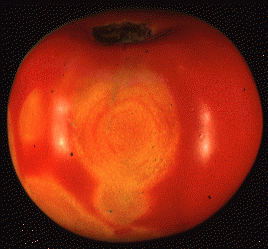 SAN JOAQUIN VALLEY - Tomato Spotted Wilt Virus (TSWV) in tomatoes has been increasing, both in the southern San Joaquin Valley as well as in San Joaquin County, according to Brenna Aegerter, vegetable farm advisor for the county. While there have been “hot spots” of high disease incidence especially down south, “the majority of fields have just a few infected plants,” according to Aegerter.
SAN JOAQUIN VALLEY - Tomato Spotted Wilt Virus (TSWV) in tomatoes has been increasing, both in the southern San Joaquin Valley as well as in San Joaquin County, according to Brenna Aegerter, vegetable farm advisor for the county. While there have been “hot spots” of high disease incidence especially down south, “the majority of fields have just a few infected plants,” according to Aegerter.
Symptoms of TSWV are bronzing of leaves followed by the development of necrotic spots and streaks on the foliage and stems, which may be followed by shoot dieback. On fruit, characteristic ringspots develop. On red fruit these can be quite striking, but they are also faintly visible on green fruit, said the veg crop farm advisor who is a specialist in plant pathology.
TSWV has an extremely wide host range, including hundreds of plants species spanning both broadleaves and monocots like as orchids and lilies.
Economic hosts in California include tomato, pepper, beans, corn, lettuce, radicchio, celery and many ornamentals.
“There are many potential weed hosts, including nightshade, purslane and pigweed. This virus is vectored by at least 10 thrips species, including the western flower thrips and the onion thrips,” said Aegerter.
After egg hatch on TSWV-infected plants, the first and second instar larvae acquire the virus. The virus reproduces within the thrips and they can then transmit the virus to healthy plants when they are adults.
“Adults cannot pick up the virus, nor can they pass the virus on to their offspring,” said the farm advisor. “Therefore, in order for a plant to be a source of the virus for new infections and spread, it must support reproduction of both the thrips and the virus.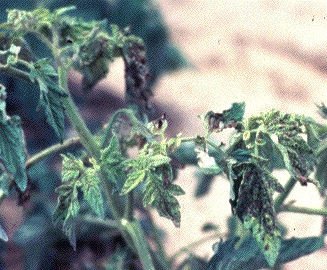
“In the past, we thought that there was no build-up or secondary spread within tomato fields because tomatoes did not support reproduction of thrips. However, observations this season of very heavily infected tomato fields adjacent to unaffected fields suggest that the vector and virus may be capable of building up within a tomato field. If this turns out to be the case, then controlling the thrips may prove beneficial in reducing the spread of the virus within a tomato field.”
Because there are so many potential sources of inoculum and because their contribution to the problem may change from year to year, there is no clear strategy for positioning tomato crops to avoid infection, according to Aegerter.
Resistant varieties have been developed for both processing and fresh market varieties and these are currently being evaluated.
“Unfortunately, where resistance to TSWV has been introduced into other crops, the resistance has nearly always been overcome by the rapid occurrence of resistance-breaking strains of the virus,” said the farm advisor.
The geographic distribution of the problem (increasing southward in the Central Valley) may reflect the effect of winter temperatures on survival of the vectors. Colder winter temperatures may limit the overwintering of the western flower thrips in the Sacramento Valley. Its development does not progress at below 49 degrees. Higher disease incidence in the San Joaquin Valley might also be due to winter vector host crops such as lettuce and radicchio. The overlap of winter and summer host crops may provide a year-round habitat for the virus and its vector, said the farm advisor.
The disease could be spreading due to mildew winters of late.
Plant pathologists from UC Davis are currently studying the outbreaks in tomatoes in conjunction with Cooperative Extension Farm Advisors who are looking for fields with high incidents of wilt.
“Hopefully we will soon have a better grasp on what factors increase the risk of significant infection,” said the farm advisor.
from Western Farm Press
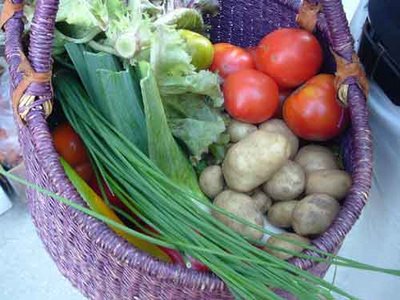 MINNEAPOLIS/ST. PAUL, MINNESOTA - If you love fresh produce, but are sick of running to the store to stock up, there's another way to make a real investment in healthy eating.
MINNEAPOLIS/ST. PAUL, MINNESOTA - If you love fresh produce, but are sick of running to the store to stock up, there's another way to make a real investment in healthy eating.
Lisa Oram loves to cook with fresh vegetables, so to keep in piles of produce at reasonable prices, she decided to skip the store and invest in a local farm.
"We get better stuff than we get at the grocery store," Oram said.
She is no farmer, but she is part of what's called a CSA or a Community Supported Agriculture farm. It is becoming a food phenomenon.
"There's about 3,000 of these farms that are doing it," said Dan Kaplan, a CSA farm manager.
Before growing season starts, members buy a share of the upcoming crop at an average cost of about $400. Then throughout the season, members receive a set amount of whatever is being harvested.
"That share roughly feeds a family with two adults and however many kids are there," Kaplan said.
If members live in a city or suburb, many farms offer drop off locations. Oram drives to her CSA and said there is no doubt she is saving money.
"I'm sure if we went to the grocery store to buy organic produce, which is what we're getting at the, at the farm, we would spend a lot more than we do in one season's share," Oram said.
Research backs that up. A study found savings of between 60 and 150 percent over retail prices for the same amount of organic produce.
But there are things to consider. Kaplan said, like with any investment, there are no guarantees.
"Shareholders buy into the risk and to the reward of farming so if there's a bad crop, we all share that loss and if there's a bounty, we all share that excess," Kaplan said.
There can be excess. A share typically amounts to between 300 and 500 pounds of produce per season.
Oram is trying a half a share and said her family is hooked.
"The produce and the value is definitely the top benefit but the other benefit is there is a community," Oram said.
Most of the farms consider their crops organic. Some are certified organic but others are not.
from WCCO / CBS
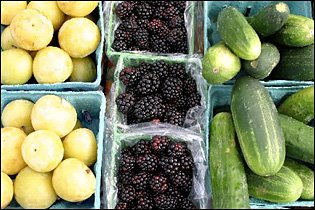 MISSOURI - Meander through a farmers market, and you may notice your thoughts about fruits and vegetables evolving. Garlic scapes, 30 varieties of apples, white peaches, salmon-colored raspberries, 14 varieties of beans, six varieties of corn. ... Over the course of the growing season, you'll see these and more.
MISSOURI - Meander through a farmers market, and you may notice your thoughts about fruits and vegetables evolving. Garlic scapes, 30 varieties of apples, white peaches, salmon-colored raspberries, 14 varieties of beans, six varieties of corn. ... Over the course of the growing season, you'll see these and more.
When you buy directly from farmers, what you won't find is out-of-season produce -- no apples in early May, no asparagus in October. Storage and shipping innovations have made most of what we eat seem seasonless, but when you buy locally grown fruits and vegetables, you'll taste the difference.
"So many people are used to opening up a cookbook, looking at a pretty picture and deciding to create a meal without really thinking about whether or not the ingredients are in season at that time," says Peggy Knickerbocker, co-author of "The San Francisco Ferry Plaza Farmers' Market Cookbook." Her book is a comprehensive guide to choosing, storing and preparing fruits and vegetables based on their seasonal availability.
When shoppers buy from the farmer, they know the food is at its peak, says Julie Ridlon, director of the Clayton Farmers Market.
"The produce is picked when it has the highest sugar content," usually not more than a few days before it is brought to the market, she says. "When you come to shop, it will be ripe."
Some markets include produce vendors, who buy from middlemen. Soulard Market fits that description. Market master Sandra Zak suggests walking around to explore what's being offered and at what prices. This strategy will give you time to decide what to buy, as well as give you a feel for the market's personality.
"The market is a great place to people-watch," Zak says. "Soulard, in particular, is one of the oldest and largest places in the region where people of every ethnicity, socioeconomic group and religion gather together to feed their families good, wholesome food."
That kind of community is vital, Knickerbocker says, and difficult to find.
"We don't have town squares anymore, and most of us are so busy in this day and age that we don't stop to catch up and spend time with others equally interested in eating well and supporting local agriculture," she says.
Ridlon agrees that visiting a farmers market is a sensory experience.
"It's about smells, sounds, sight, feel and taste," she says. "When you come to the market, everything is alive."
Even those who run the markets can be amazed by the wealth of local produce.
"There are things I saw at the market last year that I've never seen before, things like pineapple tomatillos and countless varieties of squash in all shapes and sizes," says Julia Feder, market master of the Central West End's Green Market.
"We've easily got 20 different varieties of peppers, many of which most people have probably never seen before," she says. "The grocery store only offers the basics, but at the market it's all about variety. Trying something new and different each week is truly a joy."
When in doubt about the produce on display, just ask a farmer.
"The person selling you the produce is the best expert you can get," Feder says. "I encourage people to get to know the farmers and ask them tons of questions. They want you to be as satisfied as possible with their products."
from St. Louis Today
 SAN FRANCISCO — On Wednesday morning, a white-coated food service worker hoisted a box of cherry tomatoes onto a steel table inside a massive commissary that provides almost 6,000 meals a day to 19 Kaiser Permanente medical centers in Northern California.
SAN FRANCISCO — On Wednesday morning, a white-coated food service worker hoisted a box of cherry tomatoes onto a steel table inside a massive commissary that provides almost 6,000 meals a day to 19 Kaiser Permanente medical centers in Northern California.









